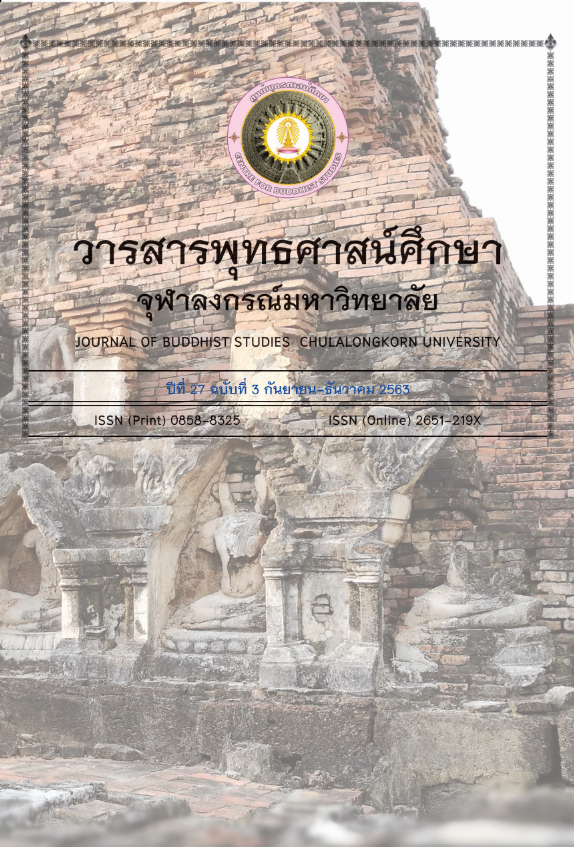Paticcasamuppāda: The Argument for the Implied Interpretation of Buddhadasa Bhikkhu
Keywords:
Paticcasamupp ā da, 12 elements, Buddhaghosa, Buddhadasa BhikkhuAbstract
Paticcasamuppāda is a key concept in Buddhist Philosophy, a product of the Buddha’s enlightenment, and a deep and wide-ranging Sutra. Paticcasamuppāda has 12 elements, including Avijjā and Sangkhāra. This article deals with the interpretative process of only the Paticcasamuppāda's structure. It seeks to present, firstly, an interpretation of the elaborated Pali terms for a more in-depth understanding; secondly, a reinterpretation of the Pali terms already expounded by Atthakathācariya and Tīkācariya. It also elaborates on the parts taken up by Buddhadasa Bikkhu. Finally, it presents an interpretation of the elements of Paticcasamuppāda concerning cause and effect, time, and other related elements. It finds no gap between the worlds of the five aggregates, no souls in suspension. Whenever a past set of aggregates ends, a present one appears in its new existence. This causal process is called Anantarapaccaya. Buddhadasa engaged in an imaginary intellectual exchange with Buddhaghosa on the cycle of rebirth. This article attempts to defend Buddhaghosa, to clarify some main Buddhist principles for new students, and to rectify misunderstandings according to the Buddha’s teachings.
Downloads
References
มหาจุฬาลงกรณราชวิทยาลัย. (2506). พระไตรปิฎกภาษาบาลี ฉบับมหาจุฬาเตปิฏกํ 2500. กรุงเทพมหานคร: โรงพิมพ์รุ่งเรืองธรรม.
มหามกุฏราชวิทยาลัย. (2539). ธมฺปทฏฺฐกถาปาลิ. กรุงเทพมหานคร: มหามกุฏราชวิทยาลัย.
มหาจุฬาลงกรณราชวิทยาลัย. (2539). ปปญฺจสูทนี มชฺฌิมปณฺณาสกอฏฺฐกถาปาลิ. กรุงเทพมหานคร: มหาจุฬาลงกรณราชวิทยาลัย.
มหาจุฬาลงกรณราชวิทยาลัย. (2539). ลีนตฺถปฺปกาสนี มหาวคฺคฏีกา. กรุงเทพมหานคร: มหาจุฬาลงกรณราชวิทยาลัย.
มหาจุฬาลงกรณราชวิทยาลัย. (2539). วิสุทธิมคฺคปาลิ. กรุงเทพมหานคร: มหาจุฬาลงกรณราชวิทยาลัย.
มหาจุฬาลงกรณราชวิทยาลัย. (2539). สมฺโมหวิโนทนีอฏฺฐกถาปาลิ. กรุงเทพมหานคร: มหาจุฬาลงกรณราชวิทยาลัย.
กองตำราคณะธรรมทาน. (2561). ปฏิจจสมุปบาทจากพระโอฏฐ์ (พิมพ์ครั้งที่ 12). สุราษฎร์ธานี: ธรรมทานมูลนิธิ ไชยา.
ฉัตรสุมาลย์ กบิลสิงห์และคณะ. (2537). ความรู้พื้นฐานทางศาสนา (พิมพ์ครั้งที่ 2). กรุงเทพมหานคร: มหาวิทยาลัยธรรมศาสตร์.
สมภาร พรมทา. (2560). แก่นเดิมของพุทธปรัชญา (เล่มที่ 1 : มนุษย์). กรุงเทพมหานคร: โรงพิมพ์ บีพีเค พริ้นติ้ง.
ทวีวัฒน์ ปุณฑริกวิวัฒน์. (2540). พุทธทาสภิกขุในบริบทของสังคมไทย. วารสารพุทธศาสน์ศึกษา จุฬาลงกรณ์มหาวิทยาลัย, 4(2), 84-104.
รัชฏะ วัฒนศักดิ์. (2543). ปฏิจจสมุปบาทในทรรศนะของพุทธทาสภิกขุ (วิทยานิพนธ์ปริญญาศิลปศาสตรมหาบัณฑิต มหาวิทยาลัยสงขลานครินทร์).
Descartes, R. (1957). Descartes’s Rules for the Direction of the Mind (Harold H. Joachim, trans). London, England: east midland printing company ltd.
Radhakrishnan, Sarvepalli, Moore, Charles A. (1953). A Source Book in Indian Philosophy. Princeton, NJ: Princeton University Press.
Downloads
Published
How to Cite
Issue
Section
License
บทความที่ได้รับการตีพิมพ์เป็นลิขสิทธิ์ของศูนย์พุทธศาสน์ จุฬาลงกรณ์มหาวิทยาลัย
ข้อความที่ปรากฏในบทความแต่ละเรื่องในวารสารวิชาการเล่มนี้เป็นความคิดเห็นส่วนตัวของผู้เขียนแต่ละท่านไม่เกี่ยวข้องกับศูนย์พุทธศาสน์ จุฬาลงกรณ์มหาวิทยาลัย และคณาจารย์ท่านอื่นๆในมหาวิทยาลัยฯ แต่อย่างใด ความรับผิดชอบองค์ประกอบทั้งหมดของบทความแต่ละเรื่องเป็นของผู้เขียนแต่ละท่าน หากมีความผิดพลาดใดๆ ผู้เขียนแต่ละท่านจะรับผิดชอบบทความของตนเองแต่ผู้เดียว






